What Is Baba Ganoush?
Baba ganoush is a luxurious Middle Eastern eggplant dip celebrated for its distinctive smoky flavor and creamy texture. This ancient dish originated in Lebanon but has spread throughout the Levant region including Syria Jordan and Palestine. The name “baba ganoush” translates roughly to “pampered father” in Arabic suggesting the dish was fit for royalty.
At its core baba ganoush consists of roasted eggplant mixed with tahini garlic lemon juice and olive oil. The signature smokiness comes from charring the eggplant directly over an open flame allowing the skin to blacken while the interior flesh softens. Traditional preparation involves mashing the ingredients together with a mortar and pestle to achieve its characteristic slightly chunky yet smooth consistency.
Unlike its cousin hummus which uses chickpeas as its base baba ganoush relies entirely on eggplant giving it a lighter earthy flavor profile. This dip serves as both an appetizer and a condiment in Middle Eastern cuisine often appearing as part of a mezze spread alongside other small dishes.
Nutritionally baba ganoush offers impressive benefits. Eggplant contains antioxidants particularly nasunin which helps protect cell membranes while tahini provides protein calcium and healthy fats. The olive oil adds heart-healthy monounsaturated fats making this not just a delicious option but a nutritious choice for your table.
Regional variations exist throughout the Middle East with some versions incorporating pomegranate molasses cumin or yogurt. Egyptian versions often include more herbs while Israeli preparations might include mayonnaise for added creaminess. The versatility of this ancient recipe allows for personal interpretation while maintaining its essential character.
Why You’ll Love This Baba Ganoush Recipe

Incredibly Authentic Flavor – This recipe captures the true essence of traditional Middle Eastern baba ganoush with its perfect balance of smokiness and creaminess. You’ll taste the difference that proper eggplant charring makes.
Simple Ingredients – You need just 6 basic ingredients to create this impressive dip: eggplants, tahini, garlic, lemon juice, olive oil, and salt. Most of these items are probably already in your pantry.
Healthier Than Store-Bought – Skip the preservatives and excess sodium found in commercial versions. This homemade baba ganoush delivers pure nutrition with antioxidant-rich eggplant and heart-healthy olive oil.
Impressive Yet Easy – Though it tastes like something from an upscale Mediterranean restaurant, this recipe is surprisingly straightforward to prepare at home with no special equipment required.
Versatile Serving Options – From mezze platters to sandwich spreads, this baba ganoush works beautifully in countless applications. It’s equally delicious with warm pita triangles or as a dip for fresh vegetables.
Make-Ahead Friendly – The flavors actually improve after a day in the refrigerator, making this perfect for meal prep or entertaining. Prepare it in advance and enjoy stress-free hosting.
Naturally Vegan and Gluten-Free – Without any modification, this recipe accommodates multiple dietary preferences, making it perfect for serving to diverse groups of friends and family.
Customizable to Your Taste – While the base recipe is exceptional, you can easily adjust the garlic, lemon, or add extra herbs to suit your personal preference without compromising the authentic character.
Ingredients You’ll Need
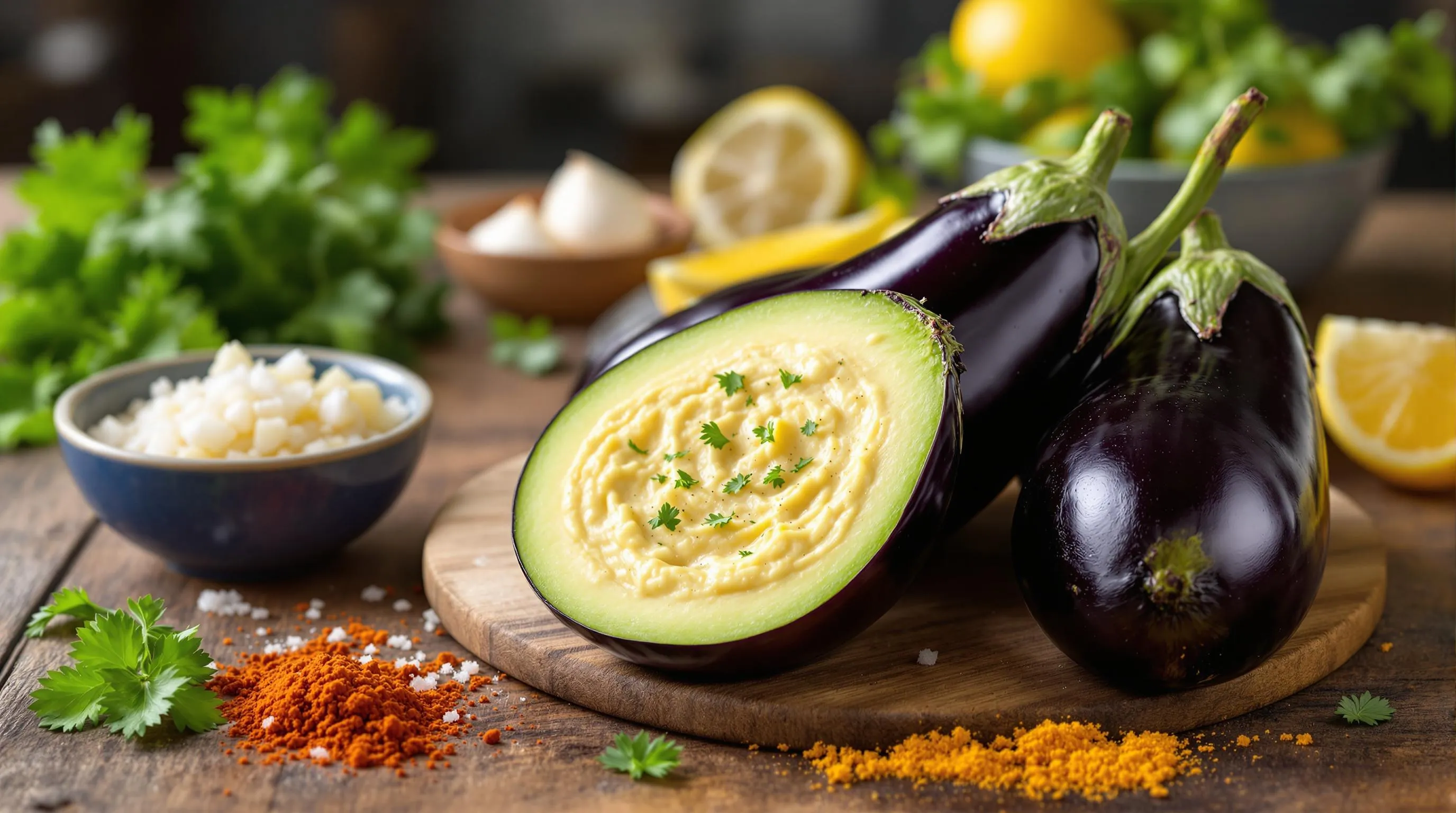
Creating authentic baba ganoush requires surprisingly few ingredients, but each plays an essential role in developing the rich, smoky flavor profile this Middle Eastern dip is known for:
- 2 medium-sized eggplants (about 2 pounds total)
- 3 tablespoons high-quality tahini
- 2-3 garlic cloves, minced
- 2 tablespoons fresh lemon juice
- 2 tablespoons extra virgin olive oil, plus more for drizzling
- 1 teaspoon kosher salt, or to taste
- ¼ teaspoon ground cumin (optional)
- 2 tablespoons fresh parsley, finely chopped (for garnish)
- Pinch of smoked paprika (for garnish)
For the best results, select firm eggplants with glossy skin and minimal blemishes. Globe eggplants work perfectly for this recipe, but Italian eggplants can serve as an excellent substitute if needed. Fresh lemons are strongly recommended over bottled juice as they provide a brighter flavor that balances the earthiness of the eggplant.
Quality tahini makes a important difference in the final taste of your baba ganoush. Look for tahini made from hulled sesame seeds with a smooth texture and no separation. Extra virgin olive oil adds a fruity note and silky mouthfeel to the dip, so use the best you can find.
Equipment Required
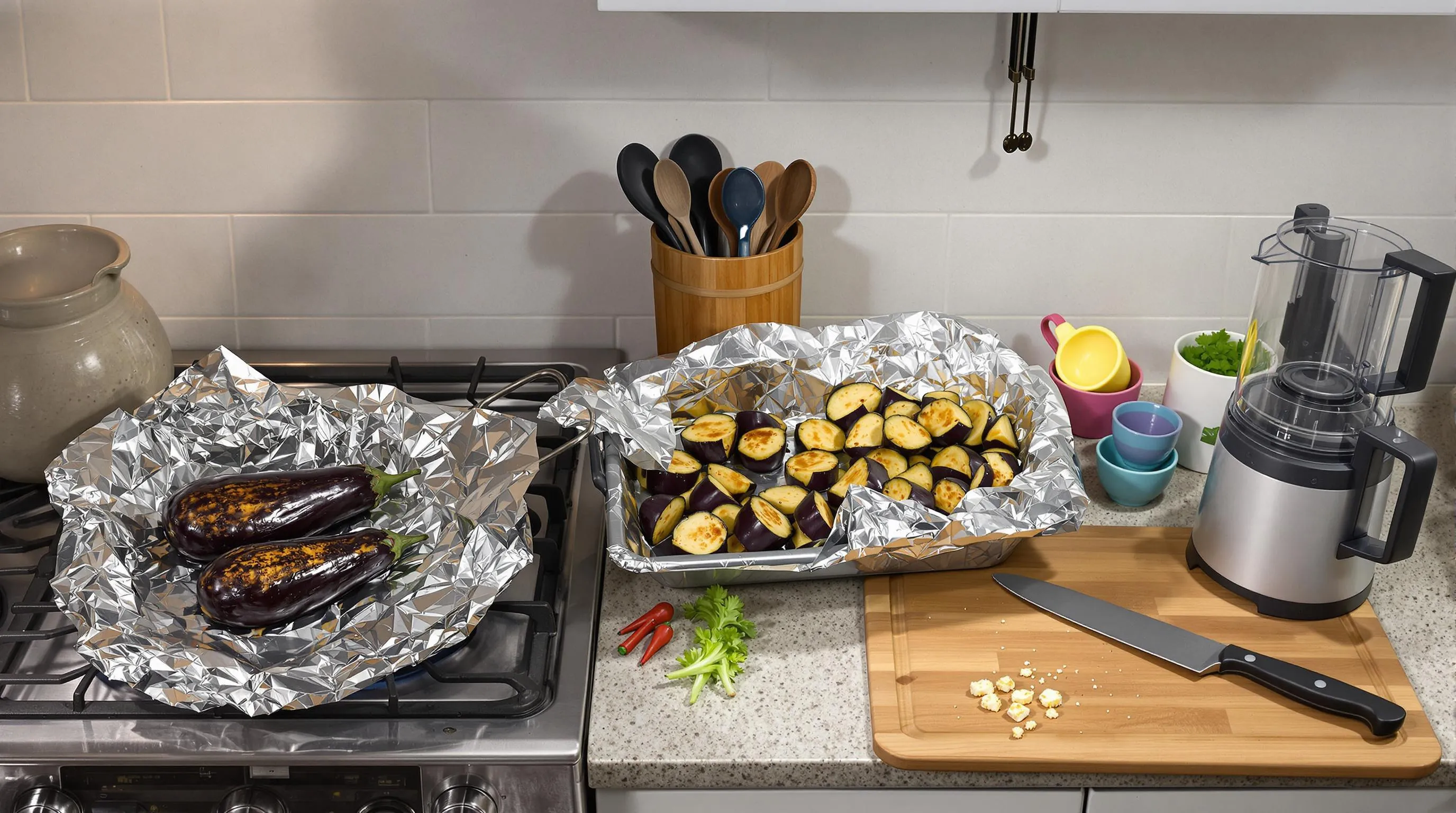
Creating authentic baba ganoush requires minimal equipment yet the right tools make a important difference in achieving that perfect smoky flavor and creamy texture. Here’s what you’ll need to prepare this Middle Eastern eggplant dip:
- Gas stovetop or grill – Essential for charring the eggplant to develop that distinctive smoky flavor
- Baking sheet – Used to roast the eggplant after charring
- Aluminum foil – For lining the baking sheet and wrapping eggplant
- Colander – Needed to drain excess liquid from the roasted eggplant
- Food processor or blender – Creates the smooth texture (though traditional methods use a mortar and pestle)
- Sharp knife – For slicing the eggplant before roasting
- Cutting board – Provides a stable surface for preparation
- Measuring spoons and cups – Ensures accurate ingredient proportions
- Mixing bowl – For combining and adjusting flavors
- Rubber spatula – Helps scrape every bit of goodness from the food processor
- Serving bowl – Preferably a shallow dish for traditional presentation
The most critical equipment item is your heat source for charring the eggplant. A gas stovetop or grill provides direct flame contact that creates the authentic smoky flavor that defines exceptional baba ganoush. Electric stovetops can work in a pinch but won’t deliver the same depth of smokiness.
Your food processor doesn’t need to be fancy – even a basic model will effectively blend the ingredients. Traditional preparation uses a mortar and pestle for a more rustic texture if you prefer that authentic approach.
How To Prepare The Eggplant

Properly preparing eggplant is the crucial first step to achieving that authentic smoky flavor that defines great baba ganoush. You have three excellent methods to choose from based on your available equipment and preference.
Roasting Method
Roasting eggplant in the oven offers a convenient option when outdoor grilling isn’t possible. Preheat your oven to 450°F (230°C) and line a baking sheet with foil or parchment paper. Pierce your eggplants several times with a fork to prevent them from bursting during cooking. Place the whole eggplants on the prepared baking sheet and roast for 45-60 minutes until they’re completely soft and collapsed. Turn them halfway through cooking to ensure even charring on all sides. The skin should look wrinkled and dark, while the interior becomes incredibly tender. Let the eggplants cool until you can handle them comfortably before proceeding with the recipe.
Grilling Method
Grilling delivers the most authentic smoky flavor for traditional baba ganoush. Heat your grill to medium-high heat and place whole eggplants directly on the grates. Grill for about 20-30 minutes, turning them every 5-7 minutes until the skin is completely charred and blackened on all sides. You’ll know they’re done when the eggplants feel soft when pressed gently with tongs. The interior should be completely tender and almost custard-like in texture. Remove the eggplants from the grill and place them in a bowl covered with plastic wrap or a clean kitchen towel to steam for 10-15 minutes—this step makes peeling much easier.
Stovetop Method
The stovetop method provides excellent results for smaller eggplants and offers intense smokiness. Turn a gas burner to medium flame and place the eggplant directly on the grate over the open flame. Use tongs to rotate the eggplant every few minutes, allowing the skin to char evenly on all sides. This process takes approximately 15-20 minutes depending on the size of your eggplant. The skin should become blackened and blistered while the flesh inside softens completely. Allow the charred eggplant to cool in a covered bowl for 10 minutes before handling. For electric stovetops, this method won’t work—opt for the roasting or grilling methods instead.
How To Make Baba Ganoush
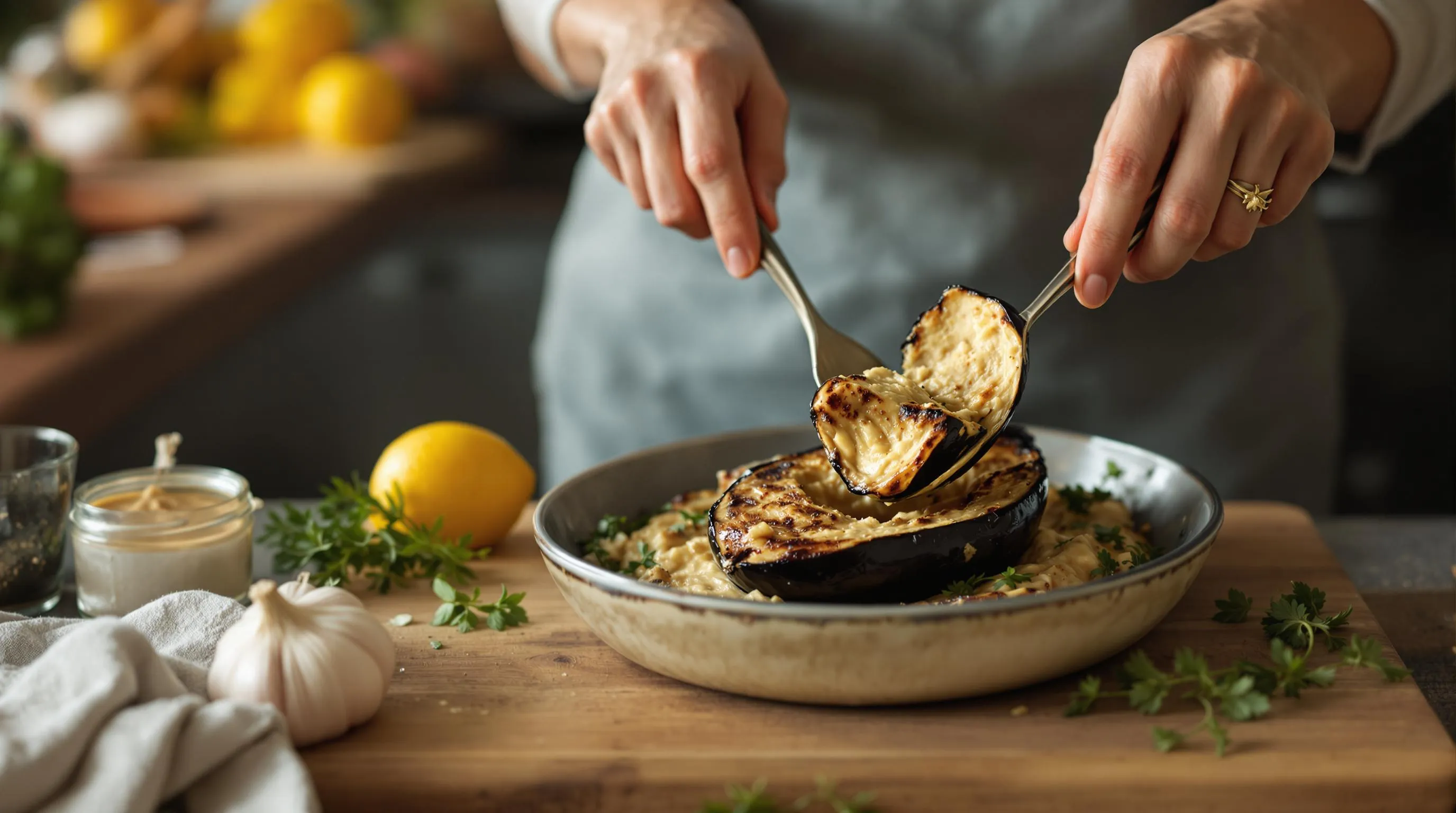
Making authentic baba ganoush requires patience and attention to detail but rewards you with incredible smoky flavor. Follow these simple steps to create this Middle Eastern classic in your own kitchen.
Step 1: Cook The Eggplant
Start by preparing your eggplants using one of the methods previously discussed—roasting in the oven, grilling, or charring over a stovetop flame. Pierce the eggplants several times with a fork before cooking to prevent them from bursting. For the most authentic flavor, the stovetop or grill method is preferred as it imparts that distinctive smokiness. Cook until the skin is completely charred and blackened and the interior feels very soft when pressed with tongs. The eggplants should look collapsed and their juices might begin to seep out—this typically takes 15-20 minutes depending on size. Turn them occasionally using tongs to ensure even charring on all sides. You’ll know they’re done when you can easily pierce them with a knife without resistance.
Step 2: Remove The Flesh
Once the eggplants are fully cooked, transfer them to a colander set in the sink. Allow them to cool for about 15 minutes until you can handle them comfortably. Slice the eggplants open lengthwise and use a large spoon to carefully scoop out all the soft flesh, separating it from the charred skin. Transfer the flesh to the colander to drain excess moisture—this is crucial for a thick, flavorful dip. Let the eggplant drain for at least 10 minutes, occasionally pressing gently with the back of a spoon to extract more liquid. For an even drier result, you can line the colander with paper towels or cheesecloth. Discard the blackened skin and any large seed pockets you encounter.
Step 3: Process The Ingredients
Transfer the drained eggplant flesh to your food processor. Add 3 tablespoons of tahini, 1-2 minced garlic cloves, 2 tablespoons of fresh lemon juice, and a pinch of salt. Pulse the mixture about 8-10 times until it’s combined but still has some texture—traditional baba ganoush should not be completely smooth. If using a blender, use short pulses and avoid over-processing. For a more rustic texture, you can mash everything together in a bowl using a fork or potato masher. Drizzle in 1 tablespoon of extra virgin olive oil while pulsing a few more times to incorporate it throughout the mixture. Transfer the processed baba ganoush to a mixing bowl.
Step 4: Season To Taste
Taste your baba ganoush and adjust the seasonings according to your preference. Add more lemon juice for brightness, tahini for richness, or salt to enhance the overall flavor. You might want to incorporate ¼ teaspoon of ground cumin for earthiness or a pinch of smoked paprika for additional smokiness. Stir thoroughly after each addition and taste again. For the most authentic experience, let the baba ganoush rest in the refrigerator for at least 30 minutes before serving to allow the flavors to meld together. When ready to serve, transfer to a shallow serving bowl, create a small well in the center, and drizzle with additional olive oil. Sprinkle with chopped fresh parsley, a dash of sumac, or toasted pine nuts for visual appeal and complementary flavors.
Tips For The Perfect Baba Ganoush
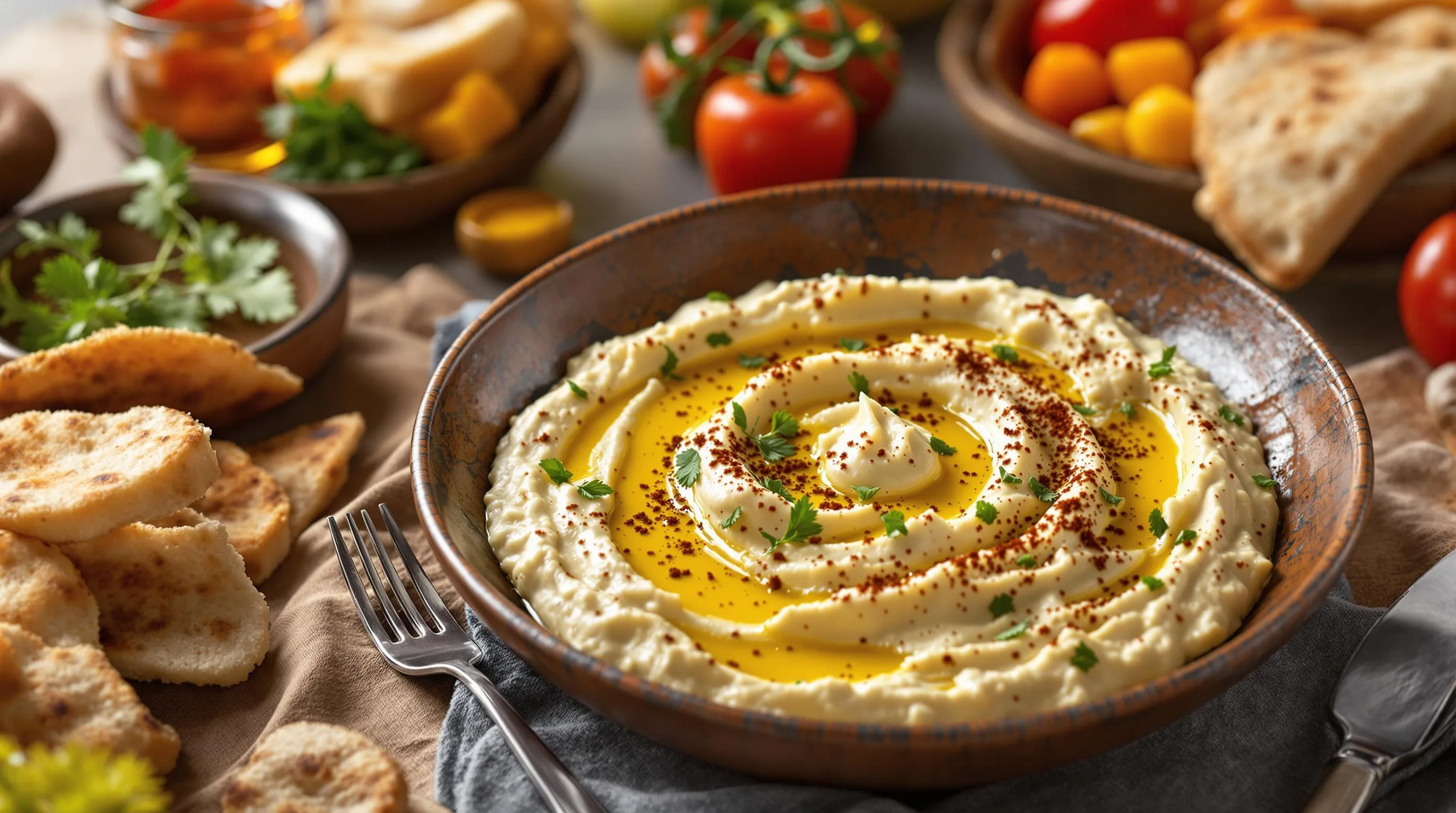
Choose The Right Eggplants
Select firm glossy eggplants with smooth skin and minimal blemishes. Globe eggplants work best for baba ganoush as they have fewer seeds and more flesh. The weight of the eggplant should feel substantial for its size indicating fresh dense flesh rather than dried out or old produce. Smaller eggplants often taste less bitter and have a more concentrated flavor that enhances your final dip.
Master The Charring Technique
Allow your eggplants to char thoroughly on all sides to develop that signature smoky flavor. Listen for the skin to crackle and watch for it to blacken completely before considering it done. Rotate the eggplants frequently during charring to ensure even cooking and flavor development. Patience during this step pays off tremendously in the final taste profile of your baba ganoush.
Drain Thoroughly
Let your cooked eggplant rest in a colander for at least 15 minutes to remove excess moisture. Press gently with the back of a spoon to extract bitter juices without mashing the flesh prematurely. This draining step prevents your baba ganoush from becoming watery and concentrates the smoky eggplant flavor. Consider lining your colander with cheesecloth for even more efficient moisture removal.
Balance Your Flavors
Adjust the garlic lemon and tahini amounts to suit your personal taste preferences. Start with less tahini than you think you need as you can always add more but cannot remove it. Taste your baba ganoush before serving and remember that flavors will intensify as the dip rests. Fresh lemon juice makes a important difference compared to bottled varieties adding brightness that balances the rich tahini.
Achieve The Perfect Texture
For traditional slightly chunky baba ganoush pulse rather than continuously blend in your food processor. Hand-mashing with a fork gives the most authentic rustic texture beloved in Middle Eastern homes. Allow some textural variation rather than processing to a completely smooth consistency. The perfect baba ganoush maintains some structure while still being creamy enough to scoop with pita.
Rest Before Serving
Let your finished baba ganoush rest in the refrigerator for at least 2 hours before serving. Overnight resting allows all flavors to meld together creating a more complex taste profile. Bring the dip to room temperature before serving to enhance its creaminess and flavor. This resting period transforms good baba ganoush into exceptional baba ganoush as the ingredients harmonize.
Presentation Matters
Serve your baba ganoush in a shallow bowl with a swirl pattern created using the back of a spoon. Drizzle high-quality olive oil generously over the top just before serving. Sprinkle with sumac za’atar or Aleppo pepper for authentic color and flavor enhancement. Fresh herbs like parsley or mint add a bright visual contrast and fresh flavor note to the creamy dip.
Storage Wisdom
Store leftover baba ganoush in an airtight container with a thin layer of olive oil on top to prevent oxidation. Consume within 3-4 days for optimal flavor and texture. Avoid freezing baba ganoush as the texture significantly deteriorates when thawed. Allow refrigerated baba ganoush to sit at room temperature for 20 minutes before serving for the best flavor experience.
Serving Suggestions
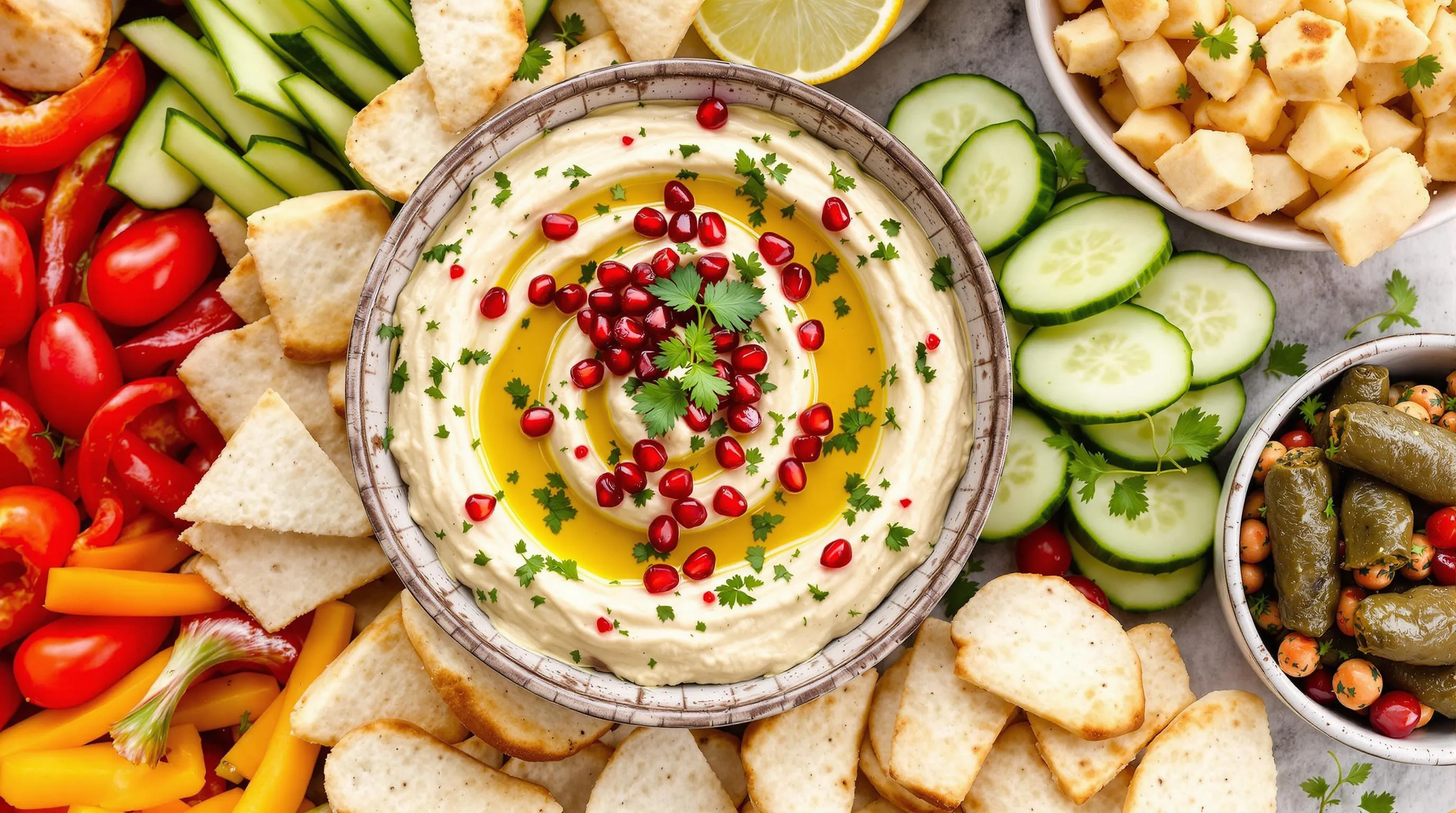
Baba ganoush thrives as a versatile dish that complements many serving styles and occasions. Traditional Middle Eastern cuisine typically presents this smoky eggplant dip as part of a mezze spread alongside other small plates. You can create an impressive Mediterranean-inspired grazing board by pairing your freshly made baba ganoush with warm pita bread triangles crisped in the oven or fluffy pita pockets.
For a lighter option serve baba ganoush with an assortment of fresh vegetable crudités such as cucumber spears bell pepper strips carrot sticks or cherry tomatoes. This combination makes a nutritious appetizer or healthy snack option that highlights the dip’s creamy texture against the crisp vegetables.
Baba ganoush also excels as a sandwich spread replacing mayonnaise or hummus in wraps and pitas. Try spreading a generous layer inside a Mediterranean wrap filled with grilled vegetables feta cheese and fresh herbs for a flavor-packed lunch. The smoky eggplant flavor particularly complements falafel sandwiches and grilled lamb dishes.
For elegant entertaining present your baba ganoush in a shallow bowl drizzled with high-quality olive oil and garnished with pomegranate seeds fresh herbs and pine nuts. This visually stunning presentation elevates the humble dip to centerpiece status at any gathering. Serve alongside other Mediterranean favorites like tabbouleh Greek salad or stuffed grape leaves for a cohesive themed spread.
Baba ganoush pairs exceptionally well with grilled meats especially lamb chicken or beef skewers. The creamy texture and smoky flavor provide a perfect counterpoint to the charred meat. You might also consider serving it alongside roasted vegetables or as part of a vegetarian mezze platter with dolmas hummus and marinated olives.
For a contemporary twist incorporate baba ganoush into unexpected dishes. Use it as a base for flatbread pizza topped with roasted vegetables and crumbled feta or as a flavorful layer in a Mediterranean-inspired lasagna. Some creative home cooks even use baba ganoush as a sauce for pasta mixing it with a bit of pasta water for a creamy eggplant coating.
When serving baba ganoush allow it to come to room temperature about 30 minutes before presenting it to your guests. This brief rest enhances its flavors and creates a more scoopable consistency that makes dipping more enjoyable. Remember that baba ganoush tastes even better the day after making it as the flavors have time to meld and develop fully.
Storage And Make-Ahead Instructions

Baba ganoush actually improves with time as the flavors meld together in the refrigerator. You can prepare this Mediterranean dip up to three days ahead of when you plan to serve it which makes it perfect for entertaining or meal prep.
To store your baba ganoush properly transfer it to an airtight container and refrigerate immediately after cooling. The dip will maintain its best quality for 4-5 days when stored this way. Before serving refrigerated baba ganoush allow it to sit at room temperature for about 30 minutes to enhance its flavor and texture.
For make-ahead preparation complete the entire recipe then cover the surface directly with plastic wrap to prevent oxidation and drying out. This direct contact storage method helps maintain the dip’s creamy consistency and prevents a skin from forming on top.
Consider these additional storage tips for optimal results:
- Avoid freezing baba ganoush as the texture significantly deteriorates upon thawing becoming watery and grainy
- Drizzle a thin layer of olive oil on top before refrigerating to create a protective seal that keeps the dip fresh longer
- If the dip thickens too much in the refrigerator simply stir in a small amount of olive oil or lemon juice before serving
- Store garnishes separately and add them just before serving for the freshest presentation
- Always use clean utensils when scooping from the container to prevent introducing bacteria that could shorten shelf life
The flavors of baba ganoush typically peak about 24 hours after preparation making this the ideal make-ahead appetizer. Preparing it a day in advance allows the garlic to mellow and the smoky eggplant flavor to fully develop throughout the mixture.
Variations To Try
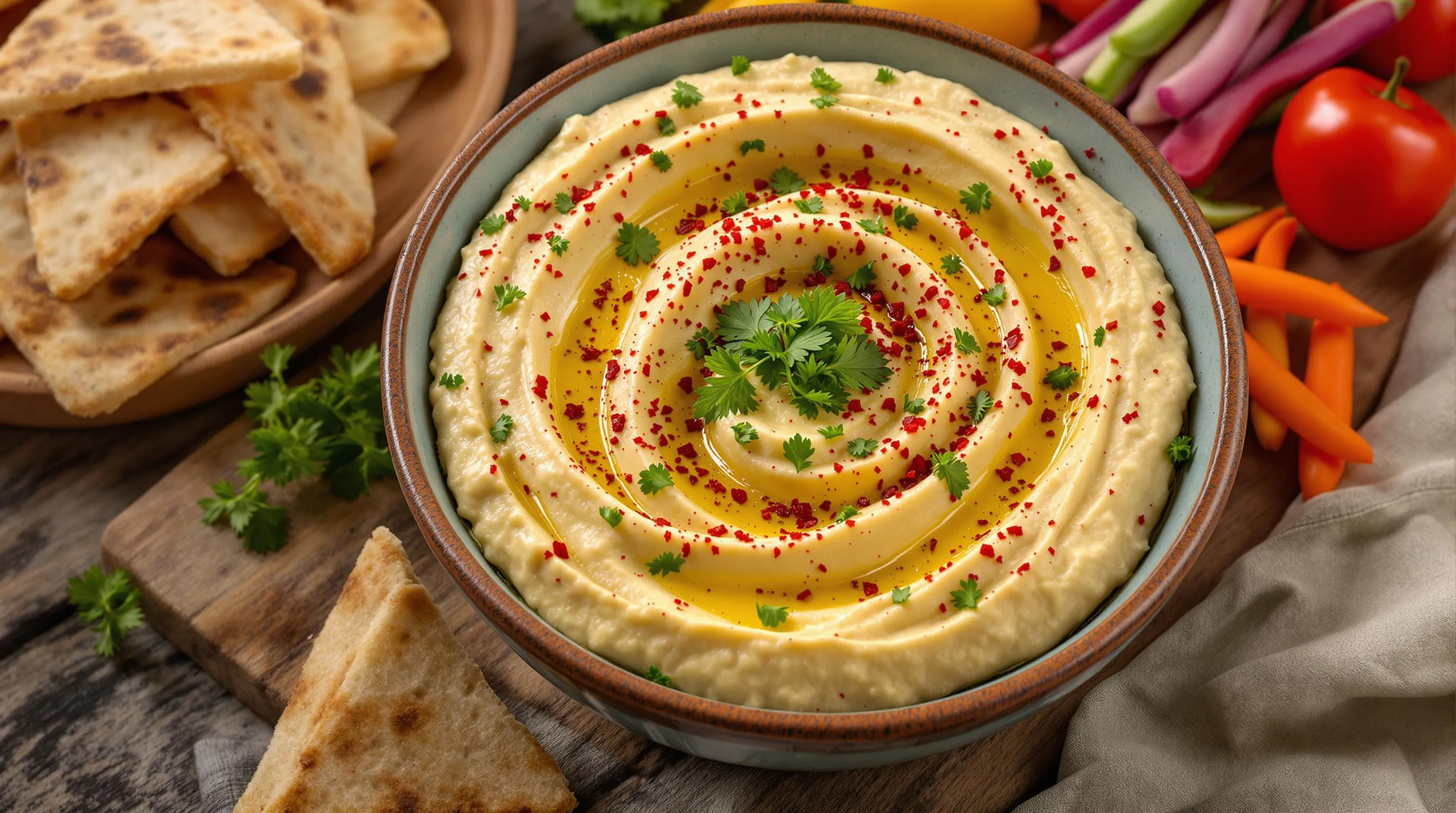
While traditional baba ganoush is delicious on its own, experimenting with different flavors can create exciting new versions of this classic dip. Try these creative variations to discover your personal favorite.
Spicy Baba Ganoush
Add a fiery kick to your baba ganoush by incorporating spicy elements that complement the smoky eggplant base. Mix in 1-2 teaspoons of harissa paste or ½ teaspoon of cayenne pepper for a North African-inspired heat. Fresh jalapeños or serrano peppers (1 small pepper, seeded and finely chopped) integrate beautifully with the creamy texture. Red pepper flakes make an excellent garnish, providing both visual appeal and customizable spice levels. For a more complex heat profile, try adding ¼ teaspoon of Aleppo pepper which offers fruity notes alongside moderate spiciness. Remember that heat intensifies as the dip sits, so start conservatively and adjust to your preference before serving.
Herb-Infused Baba Ganoush
Fresh herbs transform traditional baba ganoush into a vibrant green-flecked dip bursting with aromatic flavors. Fold in 2-3 tablespoons of finely chopped fresh herbs after processing the main ingredients. Flat-leaf parsley adds classic Middle Eastern freshness while mint brings cooling notes that balance the smoky eggplant. Cilantro creates a bolder variation popular in some regional interpretations. Dill introduces a unique tanginess that pairs wonderfully with the creamy texture. Try a blend of herbs for more complexity or focus on a single herb for a distinct flavor profile. Garnish with additional fresh herbs just before serving to enhance the visual appeal and provide an aromatic preview of the flavors within.
Roasted Garlic Baba Ganoush
Transform your baba ganoush into a mellow garlicky delight by substituting roasted garlic for raw garlic. Roast a whole head of garlic by cutting off the top, drizzling with olive oil, wrapping in foil, and baking at 400°F for 35-40 minutes until soft and golden. Squeeze the roasted cloves into your baba ganoush mixture in place of raw garlic. This method creates a sweeter, more complex garlic flavor without the sharp bite of fresh garlic. Use 4-6 roasted cloves for a subtle background note or up to a full head for true garlic lovers. The caramelized flavors from roasting complement the smokiness of the eggplant perfectly. Add a pinch of smoked paprika to enhance the roasted notes even further.
Nutritional Information
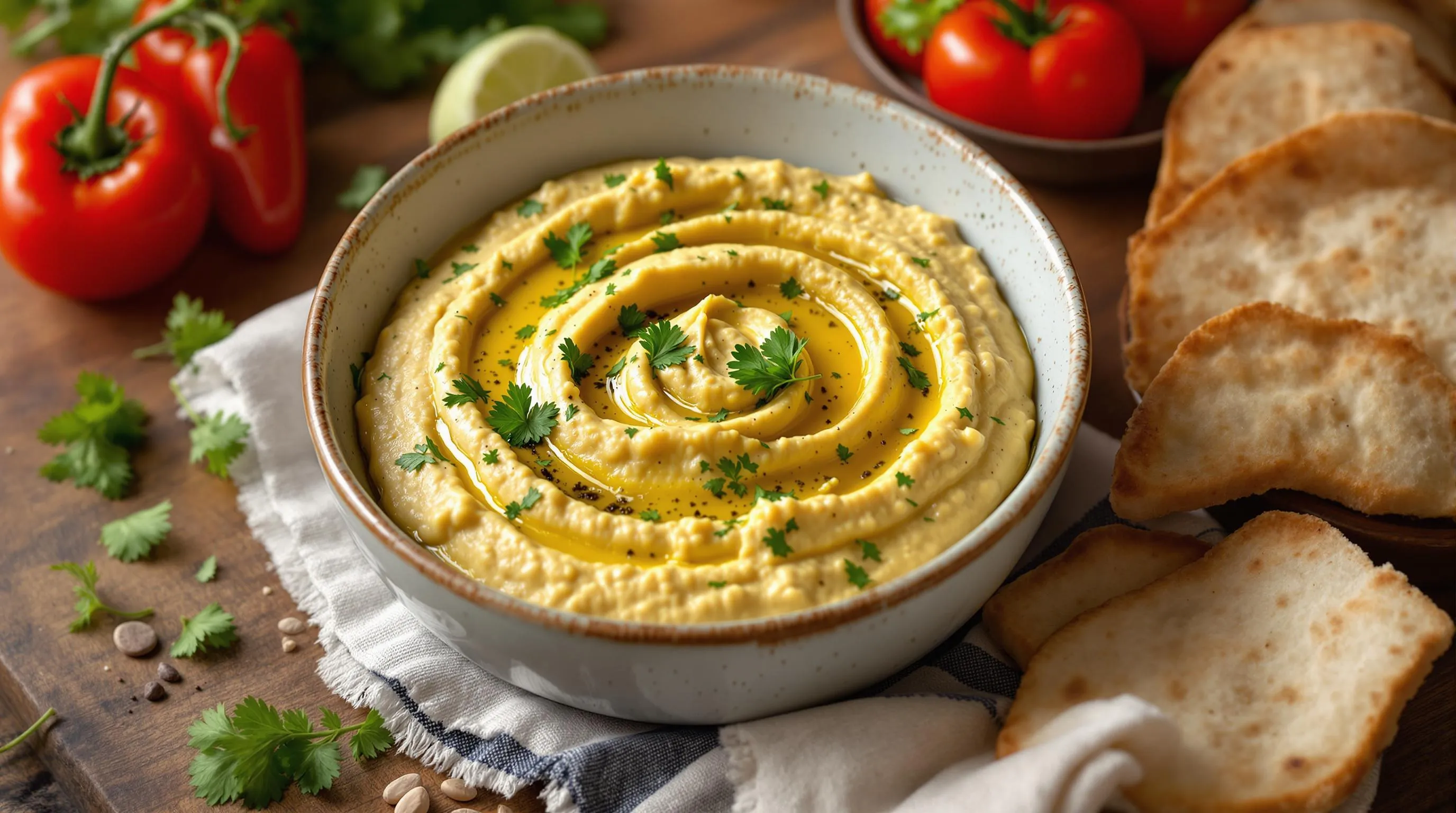
Baba ganoush offers an impressive nutritional profile that makes it not only delicious but also a healthy addition to your diet. This Middle Eastern eggplant dip provides several essential nutrients while remaining relatively low in calories compared to many other dips and spreads.
A typical serving of baba ganoush (about 1/4 cup or 60g) contains approximately:
- Calories: 120-150
- Total Fat: 10-12g
- Saturated Fat: 1.5g
- Unsaturated Fat: 8.5g
- Protein: 3-4g
- Carbohydrates: 6-8g
- Fiber: 2-3g
- Sugar: 2g
- Sodium: 150-200mg (varies based on salt added)
Eggplant serves as the primary ingredient and contributes dietary fiber antioxidants and vitamins. Tahini delivers plant-based protein along with calcium iron and magnesium. Olive oil provides heart-healthy monounsaturated fats that support cardiovascular health.
The garlic in baba ganoush contains allicin compounds with potential antimicrobial and antioxidant properties. Lemon juice adds vitamin C which helps with iron absorption and immune function support.
This nutritional composition makes baba ganoush particularly beneficial for various dietary needs. Its moderate protein content combined with healthy fats helps maintain satiety while keeping carbohydrates relatively low. The dip fits well into Mediterranean diet patterns often associated with longevity and reduced risk of chronic diseases.
For those with dietary restrictions baba ganoush presents a naturally gluten-free vegan and dairy-free option. The absence of common allergens makes it accessible for many people with food sensitivities.
The calorie content can vary depending on the amount of olive oil and tahini used in your exact recipe. You can adjust these ingredients to modify the nutritional profile according to your dietary preferences without significantly compromising flavor.
Keep in mind that serving baba ganoush with pita bread or crackers will add additional calories and carbohydrates to your overall intake. Pairing it with fresh vegetables creates a nutrient-dense lower-calorie option for enjoying this flavorful dip.
Conclusion
Baba ganoush brings the rich flavors of Middle Eastern cuisine right to your kitchen with minimal effort. This smoky eggplant dip transforms simple ingredients into something truly remarkable that will impress family and friends alike.
Whether you serve it as part of a mezze platter with warm pita or use it to elevate your sandwiches and wraps you’ll appreciate its versatility. The beauty of homemade baba ganoush lies in its authenticity and adaptability – feel free to adjust the flavors to suit your taste preferences.
Remember that patience pays off with this recipe. Allow time for the flavors to develop overnight in the refrigerator and don’t rush the charring process. Your reward will be a creamy nutritious dip that captures the essence of traditional Middle Eastern cuisine in every bite.

